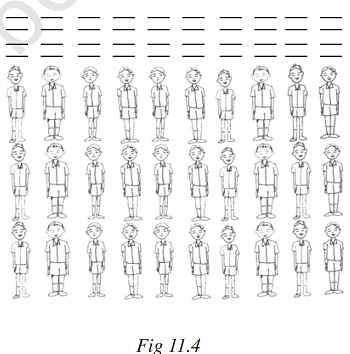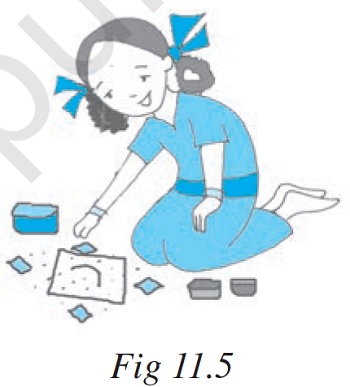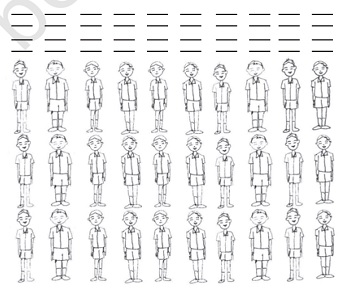11.5 More Examples of Variables
NCERT Class 6 Mathematics Textbook for Blind Students made Screen Readable by Professor T K Bansal.
We have used the letter n to show a variable. Rajeev asks, “Why not m”?
There is nothing special about n, any letter can be used.
Start of blue box
We may use any letter as m, I, p, x, y, z, etc. to show a variable. Remember, a variable is a number which does not have a fixed value. For example, the number 5 or the number 100 or any other given number is not a variable. They have fixed values. Similarly, the number of angles of a triangle has a fixed value i.e. 3. It is not a variable. The number of corners of a quadrilateral (4) is fixed; it is also not a variable. But n in the examples we have looked is a variable. It takes on various values 1, 2, 3, 4, ....
End of blue box
Let us now consider variables in a more familiar situation.
Students went to buy notebooks from the school bookstore. Price of one notebook is ₹ 5. Maanav wants to buy 5 notebooks, Arjun wants to buy 7 notebooks, Sara wants to buy 4 notebooks and so on. How much money should a student carry when she or he goes to the bookstore to buy notebooks?
This will depend on how many notebooks the student wants to buy. The students work together to prepare a table.
Table 3
| Number of notebooks required | 1 | 2 | 3 | 4 | 5 | m | ||
|---|---|---|---|---|---|---|---|---|
| Total cost in rupees | 5 | 10 | 15 | 20 | 25 | 5m |
The letter m stands for the number of notebooks a student wants to buy; m is a variable, which can take any value 1, 2, 3, 4, ... . The total cost of m notebooks is given by the rule :
The total cost in rupees = 5 × number of note books required
= 5 m
If Maanav wants to buy 5 notebooks, then taking m = 5, we say that Maanav should carry ₹ 5 × 5 or ₹ 25 with him to the school bookstore.
Fig. 11.4

Let us take one more example. For the Republic Day celebration in the school, children are going to perform mass drill in the presence of the chief guest. They stand 10 students in a row (Fig 11.4). How many children can be there in the drill?
The number of children will depend on the number of rows. If there is 1 row, there will be 10 children. If there are 2 rows, there will be 2 × 10 or 20 children and so on. If there are r rows, there will be 10r children in the drill; here, r is a variable which represents the number of rows and so takes on values 1, 2, 3, 4, ... .
In all the examples seen so far, the variable was multiplied by a number. There can be different situations as well in which numbers are added to or subtracted from the variable as will be seen below.
Sarita says that she has 10 more marbles in her collection than Anita. If Anita has 20 marbles, then Sarita has 30. If Anita has 30 marbles, then Sarita has 40 and so on. We do not know exactly how many marbles does Anita has. She may have any number of marbles. But we know that, Sarita's marbles = Anita's marbles + 10.
Let us denote Anita’s marbles by the letter x. Here, x is a variable, which can take any value 1, 2, 3, 4, ... ,10, ... , 20, ..., 30, .. . Using x, we write
Sarita's marbles = x + 10.
The expression (x + 10) is read as ‘x plus ten’.
It means 10 added to x. If x is 20, (x +10) is 30. If x is 30, (x + 10) is 40 and so on.
Start of blue box
The expression (x + 10) cannot be simplified further.
Do not confuse x + 10 with 10x, they are different.
In 10x, x is multiplied by 10. In (x + 10), 10 is added to x.
We may check this for some values of x.
For example,
If x = 2, 10x = 10 × 2 = 20 and x + 10 = 2 + 10 = 12.
If x = 10, 10x = 10 × 10 = 100 and x + 10 = 10 + 10 = 20.
End of blue box
Rajeev and Bhaarat are brothers. Bhaarat is younger than Rajeev by 3 years. When Rajeev is 12 years old, Bhaarat is 9 years old. When Rajeev is 15 years old, Bhaarat is 12 years old. We do not know Rajeev’s age exactly. It may have any value.
Let x denote Rajeev’s age in years, x is a variable. If Rajeev’s age in years is x, then Bhaarat’s age in years is (x − 3). The expression (x − 3) is read as x minus three. As you would expect, when x is 12, (x − 3) is 9 and when x is 15, (x − 3) is 12.
EXERCISE 11.1
Q1. Find the rule which gives the number of matchsticks required to make the following matchstick patterns. Use a variable to write the rule.
(a) A pattern of letter T
(b) A pattern of letter Z
(c) A pattern of letter U
(d) A pattern of letter V
(e) A pattern of letter E
(f) A pattern of letter S
(g) A pattern of letter A
Q2. We already know the rule for the pattern of letters L, C and F. Some of the letters from Q.1 (given above) give us the same rule as that given for L. Which are these? Why does this happen?
Q3. Cadets are marching in a parade. There are 5 cadets in a row. What is the rule which gives the number of cadets, given the number of rows? (Use n for the number of rows.)
Q4. If there are 50 mangoes in a box, how will you write the total number of mangoes in terms of the number of boxes? (Use b for the number of boxes.)
Q5. The teacher distributes 5 pencils per student. Can you tell how many pencils are needed, given the number of students? (Use s as the number of students.)
Q6. A bird flies 1 kilo meter in one minut. Can you express the distance covered by the bird in terms of its flying time in minutes? (Use t for flying time in minutes.)
Q7. Radha is drawing a dot Rangoli (a beautiful pattern of lines joining dots) with chalk powder. She has 9 dots in a row. How many dots will her Rangoli have for r rows? How many dots are there if there are 8 rows? If there are 10 rows?
Q8. Leela is Radha's younger sister. Leela is 4 years younger than Radha. Can you write Leela's age in terms of Radha's age? Take Radha's age to be x years.
Fig 11.5

Q9. Mother has made laddoos. She gives some laddoos to guests and family members; still 5 laddoos remain. If the number of laddoos mother gave away is I, how many laddoos did she make?
Q10. Oranges are to be transferred from larger boxes into smaller boxes. When a large box is emptied, the oranges from it fill two smaller boxes and still 10 oranges remain outside. If the number of oranges in a small box are taken to be x, what was the number of oranges in the larger box?
Q11.
(a) Look at the following matchstick pattern of squares (Fig 11.6). The squares are not separate. Two neighbouring squares have a common matchstick. Observe the patterns and find the rule that gives the number of matchsticks
Fig.11.6

in terms of the number of squares.
(Hint: If you remove the vertical stick at the end, you will get a pattern of C’s.)
(b) Fig 11.7 gives a matchstick pattern of triangles. As in Exercise 11 (a) above, find the general rule that gives the number of matchsticks in terms of the number of triangles.
Fig 11.7

